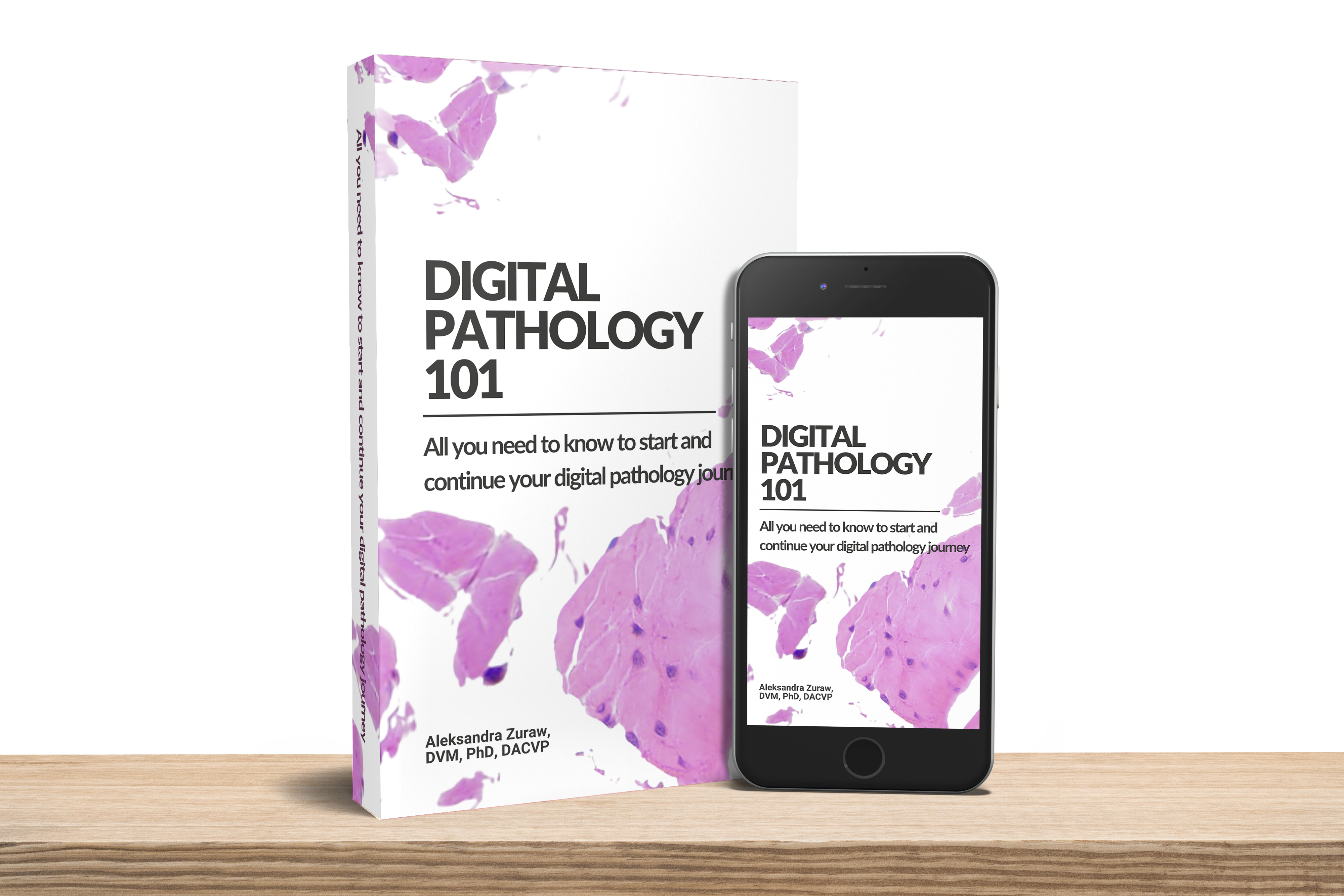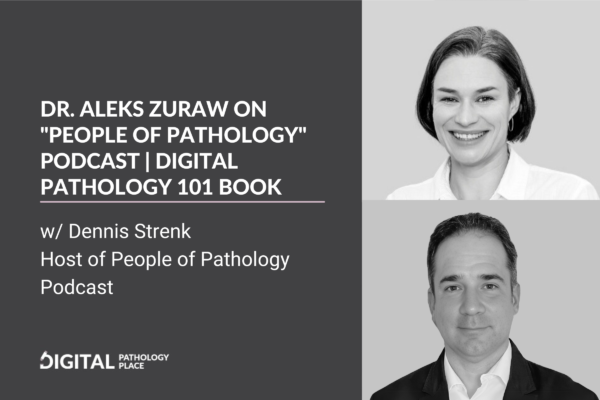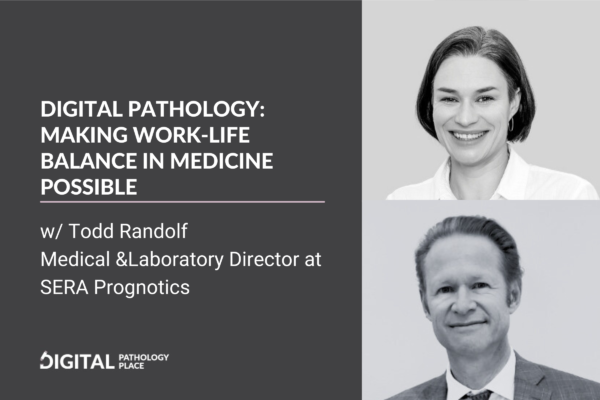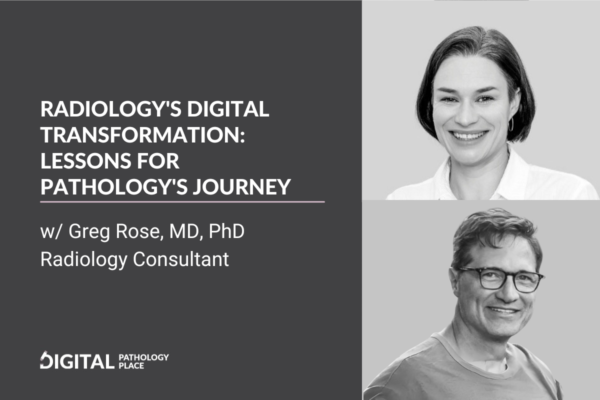Aleksandra Zuraw: [00:02:03] Hi, Esther. Welcome to the podcast. Thank you so much for joining me. How are you today?
Esther Abels: [00:02:09] I’m very good. Thank you, Aleks. How are you?
Aleksandra: [00:02:12] Good, good. I’m fine as well. Let’s start with introducing yourself to the listeners.
Esther: [00:02:18] Yeah. Yeah, as you said, I’m Esther, I’m Esther Abels. I’m originally from the Netherlands and I moved to the U S about two and a half years ago.
[00:02:26] Currently I’m the chief clinical and regulatory officer at Visiopharm. My background is in biomedical health science really. Focusing already on patients and human wellbeing. And that’s something that motivates me. And that’s also how I got involved in this industry. Actually, I started my career in pharma, where I was responsible for developing drug clinical trials and executing those as well and getting the drugs, registered on different markets, in different parts of the [00:03:03] worlds. It’s really intrigued me that I was able to get drugs on the markets and help patients to feel better. That’s an important thing for me to work on, and that’s motivates me to wake up every morning and do my job actually, because I don’t see it really as a job. I also see it as a hobby. I really have this motivation , to help patients . After I worked in the pharmaceutical industry I joined Phillips where I was joining the digital pathology departments and we got the challenge to get to whole slide imaging device on the markets in different countries over the worlds.
[00:03:43] And the biggest hurdle was of course in the U S while I say, of course, but it was in the U S because there it was regarded as a high risk device class three. And yeah we try to get that reclassified to class two device which we accomplished. And I’m very, I’m still very proud that we did [00:04:03] that as a collective community, so to say. So with different pathologists, different vendors, as well as of course, with the team at Phillips. So that’s really something that, I’m very proud of that we got that and that, that started to unlock the potential of what digital pathology can bring in the worlds of medicine.
[00:04:26] And I also give you a little bit of peak of myself, my private life, because to unwind I sport a lot. I like sports and in the past, yeah, in the past I’ve been doing rugby. I played also for the national team and I really enjoyed it a lot [00:04:44] Aleksandra: [00:04:44] Really, for the national team? You’ve played rugby for the national team?! No kidding!
Esther: [00:04:48] Yes I did. Yeah. I even was part of the world championships and it was amazing.
Aleksandra: [00:04:56] No kidding!
Esther: [00:04:56] Yeah. You speak, you live and dream rugby , and obviously I can’t do it anymore. So now I just [00:05:03] do sports to unwind after a day work. Yeah.
Aleksandra: [00:05:06] Yeah, the Philips clearance, this was THE milestone of digital pathology.
[00:05:11] And whenever I look up the details of the clearance, it’s your name on the letters to the FDA. You were the regulatory person who contributed in this regulatory area to making this happen, so totally something to be proud of and it’s going to be on the records forever.
Esther: [00:05:29] Yeah. Thank you.
Aleksandra: [00:05:31] You are also the co- author of the recent paper, “Aligning reimbursement for digital pathology with its value” in the Journal of Precision Medicine.
[00:05:40] So when I think of reimbursement in pathology, the first thing that comes to my mind is IHC. You’ll have a defined test. Marker. IHC marker, or a panel of markers improving or enabling the diagnosis of a particular disease. This has an established pricing, but digital pathology is not a single test. Let’s start with [00:06:03] explaining where reimbursement can be applied in digital pathology.
Esther: [00:06:07] Yeah. Good question. And I also would like to point out that I’m very happy that we did this with the entire team to author this paper, because I think there is a need to better understand indeed, how can you apply reimbursement in digital pathology and what is needed to really drive this field forward?
[00:06:25] Because at this moment, digital pathology can use the same existing reimbursement codes that have been around for pathology for using the microscope, actually. And you can use all these different codes for reimbursement as usual. For example, if you review a case, you can apply a different CPT – the current procedural terminology codes, that is for the current procedural terminology.
[00:06:49] So within the CPT system, you have a technical component, as well as a professional component. You can apply that in digital pathology too. And the professional component is really, as it [00:07:03] says, for the healthcare provider, the supervision and interpretation, for example, and the technical component is really applying to all the supplies, the equipment that you’re using.
[00:07:16] And if you look at that, then you also have the global components. And that is actually when there is no division of the cost associated with a medical service, because the service for example, was provided by a single entity. If you’d done indeed, look into the habit as background information. you can think about the CPT codes that are related to pathology are in ranges from 80 thousands to 89 nine, nine, nine.
[00:07:46] So it’s a long range and pathologists can use that codes. But if you now look at digital pathology itself you can only and pathology also, by the way, you can only use one code per test. So if you have, for example an [00:08:03] IHC stain, as you were saying, then you can use a code, which is, everybody knows that eight, eight three six zero or eight eight three six one, but you can only bill that once.
[00:08:17] So you use either one of them. And if you, for example have stained the slides and you use the billing codes and you find out that the staining is of insufficient quality to make a diagnosis for a patient, which happens quite often, I think about 30% of the cases are stained incorrectly.
[00:08:37] Then you have to restain you first have to recut , then you have to restain and you go through the entire process there is waiting time, and then you cannot bill again for that same stain. So you can only bill it once. And that’s something that, that I think is important to realize that you can only use a code once.
[00:08:56] However, you can add codes on top of each other. So that’s the ad-ons of code. So you can say, we [00:09:03] now use an H&E stain, now we used IHC stain, et cetera. And the distinctions also what I would like to point out, because you specifically asked about IHC stains. There is between eight eight, three, six zero and eight eight three six one that eight eight three six one includes that you can use computer edits assisted technology to provide a diagnosis.
Aleksandra: [00:09:23] Let us take a step back and explain how reimbursement works in the US, we’re talking about the US reimbursement system in general. You mentioned that CPT codes, it’s a set of codes that can be billed , who is making those codes, who is billing those codes, who is paying later for use of those tests with the codes. Could you briefly explain that?
Esther: [00:09:48] Yeah. Yeah. And that’s exactly what I think is important to realize that there are so many different entities involved with regards to this coding and the coding already, by the way, exists for decades. I think it was first published somewhere in the sixties [00:10:03] and the 1960s just may need to code procedures, many surgical procedures and there, after it started to be adopted by the centers for Medicare, Medicaid services, CMS as we know them.
[00:10:14] And then they started to use that also for insurances and reimbursements. So how today the system works is that you have three categories in CPT codes. Category one is really about the medical procedure or services provided by a healthcare provider. Category two is really about supplemental tracking codes.
[00:10:38] That’s really about performance measurements. And then category three is really about temporary tracking codes for new and emerging technologies. That’s why I also mentioned is because this could be something that we can look into. What I think what would be good to realize what’s new categories is that they’re released, for example, twice a year.
[00:10:59] And they have to be reviewed and accepted before you can get from [00:11:03] CMS a typical allocation of what will be reimbursed then with regards to responsibility of who. Modifies and updates codes, et cetera. It’s, everybody can ask for a code any individual, healthcare provider, for example, hospital, third party payer, et cetera, can submit an application for a code.
[00:11:24] Then there is a staff within the. AMA and that’s that is the American boards, that they can review the codes and then they will collect information and review if it has already been requested before, then they will accept it to be further justified whether you can get a reimbursement, if there are sufficient evidence.
[00:11:45] And then they refer that application to an editorial panel, which have a few members in there, which are experts, as appropriate. So there is another stakeholder category there. And then they can approve those codes and especially I think regarding category one, which is for the procedure codes and be [00:12:03] true for the new technologies.
[00:12:04] The panel really has to vote whether they believe that the sufficient evidence that it will be sufficient to get a code, to get reimbursements. And once that’s done, then of course, we need to have all the administration done that it gets into the system, et cetera. This entire process can take about 18 to 24 months.
[00:12:24] So it is a long time. Having said that’s one category that you have to think of the CMS itself, then the AMA, as I mentioned, then the panel with experts, but then you also have the payers themselves. So once CMS says, yes this can be reimbursed then there are payers. They all have different policies, how to apply the codes, how much they will reimburse.
[00:12:50] So CMS gives a certain amount. The payers will agree with their specific customers on what they reimburse to their customers based on their contracts. So in conclusion, actually, if you want to be [00:13:03] good or get a better contract with a payer you have to show that your device, for example in digital pathology, your device and your procedure is better.
[00:13:13] So if you then even want to implement it in your own lab, you have to show within your own standard of care, that you’re better. And you have to show that to all the stakeholders because they’re all influencers.
Aleksandra: [00:13:25] So you say you have to show that it’s better. So we basically have to justify in front of all the stakeholders , why you even should get money back for this test or for procedure performed on a digital device.
[00:13:39] So when it comes to digital technologies, and digital pathology specifically, what would justify reimbursement?
Esther: [00:13:47] Yeah, that’s actually it’s coming down to most of the time to reducing costs. So also in our paper, we discussed that we should try to move away from that by showing more the evidence-based [00:14:03] value.
[00:14:03] And I can think about three categories that you can use to justify reimbursement and that’s, for example, the practice impacts the clinical impacts and the economic impacts. If you think about practice impacts, it’s more towards improved patient experience. Clinical impact is more related to improve patient outcome.
[00:14:23] And the economic impact is more reduction of downstream costs. So that’s what you could use to justify, to have for digital technologies and also in general, for digital pathology to apply for a code and also get a code that aren’t some other initiatives also within CMS, for example, they have like new technology add on payment system, the NTAP and a good example of that is they had a device approved and as from viz. ai to analyze stroke images. So it’s radiology related, but I think that’s a good technology that we [00:15:03] can use as an example, to show that it’s justified to come up with new digital technology that’s for example, can reduce in time to treatment for stroke and can improve the clinical outcomes of patients.
[00:15:15] And we can apply the same analogy in digital pathology. Another example, and that’s also what we discuss in the paper is a PLA code, propriety lab code, and proprietary lab application code. And that’s a payment assignment process where you can include all your R &D costs, I would say because the PLA coding system allows you for creation of code specific to a particular offerings application.
[00:15:41] That’s refers back to what I mentioned earlier is that you could instead of doing all the add-ons, you can say, no, this is an entire application code. For the entire application that we’re using to improve the clinical outcome for a patient. Then are two other things that I do want to mention is have now with also it’s the [00:16:03] digital pathology we’re seeing more and more that we’re going into the pharma business as well, by saying we can be a kind of a tool to support companion diagnostic, or even we can become a companion diagnostic to predict patient outcome.
[00:16:18] And if we will get a companion diagnostic, then that justifies already straight away to get a code, just like the breakthrough designation for devices. If the FDA gives you as a very novel device, that you’re specific that you can improve patients outcome, that you can improve healthcare. You really have to show that you’re better than the standards of care .
[00:16:42] Then you will get an a, that bill is just implemented. Then you can get at least two years already a code . And that relates to what I was saying, that it takes about two years to get a new coach when you apply for it. And so that actually supports innovation. And in this digital era, we go so [00:17:03] fast that with developing new devices that you could use that they use that should justification.
[00:17:10] And yeah just to say, is that I think we focus in the past too much on data collection and storage with, within digital pathology. And it really. Yeah, actually, it’s under estimating or under selling what the potential value of digital pathology has. We need to start thinking about the value, for example, can you standardize?
[00:17:34] And we noticed H and E staining is difficult to standardize. The cap doesn’t have guidelines really for that. Using digitization using applications in your pre analytics to analyze how well you’re stain is over time. If it’s fluctuating, use it, for example, and proficiency testing, you can improve your quality. And with that also improve turnaround time reducing maybe reconfirmation testing for patients. So think that [00:18:03] is where we should focus on, on those values and There are three categories I would say. And that’s one is in the pre analytics workflow. We can show value. The second one is really that we can perform now analysis that were previously impossible with traditional pathology.
[00:18:21] That’s something that you, for example, couldn’t have seen with the human eye or what I mentioned before towards companion diagnostic, that you can start stratifying information and inform possible treatment ideas. And there’s the third one that really it supports improvements in the clinical care, at a higher level at a health system or even the population level.
[00:18:42] So that’s a long story. And I would like to say in conclusion reimbursement is justified when we focus on the needs where it provides them new value. And then we need to align on the evidence needs for this value that it’s clinical utility and cost effective tools and use them the [00:19:03] engagement with the guideline bodies because they drive the decision making on coding and the key stakeholders and use patients also who can support these guidelines and support coverage and payments.
Aleksandra: [00:19:15] For digital pathology, you advocate for value-based reimbursement. How can you create evidence necessary to justify this reimbursement, especially in this paradigm of value-based instead of just a fee per service-based?
Esther: [00:19:30] That’s indeed a key question and I think it’s really important that we think about that there’s limited work done so far to support the understanding of the health economic impacts and patient improvements. So I think what we need to start thinking about is to articulate what the services is that we provide and what is it then that it’s uniquely provided to the individual patients.
[00:19:54] And we need to identify what is the data that we need to figure this out and to make sure that not only [00:20:03] the fee goes for the technology, component of the code, but also to the physician’s fee. I think what we should be doing is defining key endpoints and outcomes, and that we have to outline these relevant to demonstration of the value, and of the technology.
[00:20:19] And I can think about evaluate some improvements in responses to therapy or delay in disease, progressions. Those are useful or think about benefit-risk assessments health economics, like cost effectiveness data. And they used a different stakeholders to and in the hospital system to define what is for them important and what is for them, the key value in in those drivers and those decision-makings.
[00:20:43] And then you can identify those key end points. And another one is to really compare it to the current care paradigm. And I can think of, for example, that you can look into existing care decision-making and treatments patterns and charts that already there, or claims analysis, and they use codes in [00:21:03] the payer databases. So you can do an analysis on that and identify key data sets where you believe you could make a difference and then utilize, for example, those new reimbursement codes and start suggesting those. Really also pursue that you get those new CPT codes and why I’m saying that is that I think if we then identify on those separate codes, you can start to saying, if we combine them, instead of add on codes, you can use the PLA coding system, which really creates new value for digital pathology.
Aleksandra: [00:21:37] So if we took a tangible example, let’s take an image analysis test that could potentially get reimbursed. What would be the road to take it, to actually obtain this reimbursement? Could you walk the listeners through the process with a tangible example?
Esther: [00:21:57] Yeah. I’d like to pick an application that we recently have put on the [00:22:03] markets in Europe, metastasis detection application. It’s also available of course for research use in the U S not for diagnostic purposes. I have to say that, of course. But we could approach that in a way as using, for example, that you can have a technical component as well as the pathologists components, right? Because in defining metastasis, you need to review a lot of negative slides and from lymph nodes. And it’s good range, even in one case, it could range from few to over 60 slides in a case. Finding then that one slide with the metastasis is sufficient to diagnose a patient has metastasis, but you still have to review all the other spots. So this is very cumbersome. And with the metastasis app, you can automate it and save time.
[00:22:50] Coming back to what I’ve said before that reducing costs is not the only added value of digital pathology. The value proposition really lies in adding value to care. So using then [00:23:03] this app example, You could say, okay, the software, we all know that’s that specifically for this app, but so far could be more precise, more consistent than a person.
[00:23:14] And also moreover software doesn’t really get tired and this could increase quality. So that’s something. Then we could add that it says it results in faster turnaround time of this particular case because the software run. Okay. Is diagnosing something else or maybe doing something else. And then you already have the results back when you really assess the patients.
[00:23:37] Even more, with this faster turnaround time for this particular case, it’s also good results of faster turnaround times of other cases, because now the pathologist doesn’t have to spend a lot of time on this tedious case. The pathologist can also spend more time on a more complex case. So, reducing also therefore that complex case for that patient the time of getting [00:24:03] a diagnosis. This then goes if you then look downstream, then the patients know earlier that they have metastasis or the other patient for this particular case had known early what kind of disease it has. And with that also, we know probably a more accurate, that’s something also that we just said more precise.
[00:24:22] Then we could show that also there, we have earlier access to treatments earlier, patient management, and as such, you have shorter treatments times, for example, and you improve really the patient’s care. And with that, you could think about using then again, the entire PLA codes specifically for this particular offering.
[00:24:46] And that is, I think that’s. You can use these types of endpoints for this specific app and highlight that we have some limitations in the current care paradigm, but what we can also provide as a reward, as an incentive, and what [00:25:03] unique benefits applications could bring in digital pathology.
Aleksandra: [00:25:06] This reimbursement and insurance and healthcare system in the US is quite a complicated maze of different dependencies. From my perspective, what you just told me is that the thing where reimbursement can be justified has to be better than what we have so far, and we have to convince a lot of stakeholders that it actually is better and gather enough evidence. Thank you so much for taking us through this maze and explaining this. I obviously will link the paper that you co-authored in the show notes. Thanks so much for being my guest.
Esther: [00:25:45] Yeah. Thank you. It’s my privilege to, be our guests and I really enjoyed the conversation. Thank you so much.
Aleksandra: [00:25:52] Have a great day Esther!
Esther: [00:25:54] Thank you too.















